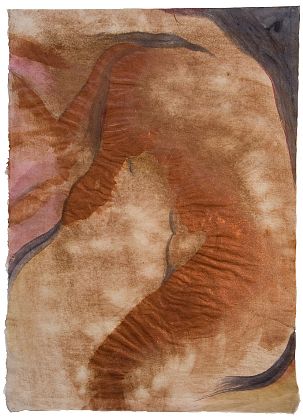The title of Mary Heebner's rapturous show, "Intimacies/Intimismos," suggests a felicitous pairing of her watercolors on paper with handpicked love poems of the Chilean Nobel Laureate Pablo Neruda. The poems proclaim, magnificently, the love to be found in the mundane and the unexpected, that inanimate objects are anything but. But the pieces themselves focus attention on the continued relevance of the human body as a focal point for contemporary realism. The show elicits our gratitude by dispensing with postmodernist tropes that turn the praxis of representation into a clinic of plastic surgery. If recent aesthetics have nipped and tucked the human body - its identity, its politics, its gender, its historicism, and its capacity for bewonderment - into an unwieldy mannequin of pastiche and irony, then this show suggests that the recent artistic history of the un-retouched human body is far less than the sum of its siliconed parts and that this fascination with procedure itself should not occlude the ability of the human body to evoke pictorial magic.
Intimate these copper pigment and graphite works indeed are. The product of a confident artist who, literally, is comfortable in her own skin, these works are tellurical and sensuous. They depict writhing male and female bodies that respond to feathered touches and Richter Scale inspirations. Inspired by a visit to Neruda's home in Isla Negra, Heebner's truncated bodies suggest antique copper, ochre, and rose-tinted maps that describe a topography of amour fou: isthmus-pudenda, sand-bar-thighs, harbors-breasts, and other shoals, reefs, crevices, peaks, and outcroppings shorn of spatial and anatomical references. As viewers we navigate these 18 pieces like Christopher Columbus, seeking one thing, finding another, across a landscape of sculptural eruptions of mass and void, convexity and concaveness, all of which gives a whole new meaning to the figure/ground relationship.
Her work dissolves the contradiction of their iteration in ephemeral watercolor (we're mostly water, anyway) and her desire to use it to describe the effect of enduring love. It suggests that love is an episodic cycle of shifting tectonics and weathered, atmospheric dissolutions, of virginal landmasses formed by sudden and potent though long in the making volcanic eruptions. Heebner's Baedecker guide to the Hemisphere of Love includes the scrumptious double-entendre titled Ars Magnetica in which the atomized souls of human bodies are inexorably drawn to one another. There's the wedge of crème caramel-lickable Sweetness Always/Dulce Siempre. There's the proud female continent of "With Her/Con Ella," the passion-blustery "Thunderhead," the seasonal refulgence of "October Fullness," the grotto-loveliness of "Muse of the Deep Earth," and the open-sesame vulnerability of "Xanadu." Carefully treading these pieces prove, as nothing else can, that love is a passportless continent with its own climate.
The exhibition more-than-ably demonstrates that the pairing of poetry and art is a suitable vehicle for a metaphor for the circumnavigation of the human body via desire and attraction. The series recalls the opening sentence of Stephen Vincent Benet's insanely visual poem "Difference:" "My mind's a map. A mad sea-captain drew it/Under a flowing moon until he knew it."

